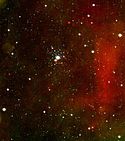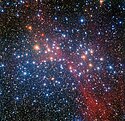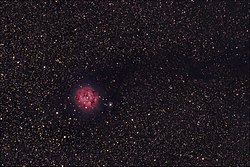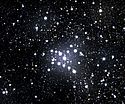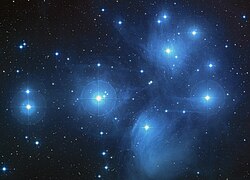Collinderův katalog
Collinderův katalog je astronomický katalog 471 otevřených hvězdokup, který sestavil švédský astronom Per Collinder. Byl vydán v roce 1931 jako příloha Collinderovy diplomové práce s názvem On structural properties of open galactic clusters and their spatial distribution.[1] Položky Collinderova katalogu se označují názvem Collinder, zkratkou Col nebo písmeny Cr, za kterými následuje katalogové číslo z rozsahu 1 až 471 (např. Collinder 50, ale též Col 50 nebo Cr 50).[2]
Seznam významných objektů
| Označení objektu | Název, číslo (NGC) | Běžný název (anglicky) | Obrázek | Vzdálenost (světelné roky) | Souhvězdí | Vizuální magnituda |
|---|---|---|---|---|---|---|
| Cr 2 | NGC 129 | 9 900 | Kasiopeja | 6,5 | ||
| Cr 6 | NGC 188 (Caldwell 1) |  | 4 800 | Cefeus | 8,1 | |
| Cr 12 | NGC 457 (Caldwell 13) | Človíček (Owl Cluster, ET Cluster) | 6 500 | Kasiopeja | 6,4 | |
| Cr 13 | NGC 559 (Caldwell 8) |  | 4 100 | Kasiopeja | 9,5 | |
| Cr 14 | Messier 103 (NGC 581) |  | 7 160 | Kasiopeja | 7,4 | |
| Cr 20 | NGC 663 (Caldwell 10) | 6 850 | Kasiopeja | 7,1 | ||
| Cr 23 | NGC 752 (Caldwell 28) | 1 300 | Andromeda | 5,7 | ||
| Cr 24 | NGC 869 (Caldwell 14) | Dvojitá hvězdokupa (Double Cluster, H & χ Persei) | 6 800 | Perseus | 3,7 | |
| Cr 25 | NGC 884 (Caldwell 14) | Dvojitá hvězdokupa (Double Cluster, H & χ Persei) | 7 600 | Perseus | 3,8 | |
| Cr 42 | Plejády (Messier 45) | Plejády, Kuřátka, M45 (Pleiades, Seven Sisters) | 440 | Býk | 1,6 | |
| Cr 50 | Hyády (Caldwell 41) | 153 | Býk | 0,5 | ||
| Cr 67 | Messier 38 (NGC 1912) | 4 200 | Vozka | 7,4 | ||
| Cr 70 | Orionův pás | 800-1300 | Orion | 0,6 | ||
| Cr 71 | Messier 36 (NGC 1960) |  | 4 100 | Vozka | 6,0 | |
| Cr 75 | Messier 37 (NGC 2099) |  | 4 511 | Vozka | 5,6 | |
| Cr 82 | Messier 35 (NGC 2168) |  | 2 800 | Blíženci | 5,1 | |
| Cr 83 | NGC 2169 | (The '37' Cluster) | 3 600 | Orion | 5,9 | |
| Cr 99 | NGC 2244 (Caldwell 50) | součást mlhoviny Rozeta | 5 200 | Jednorožec | 4,5 | |
| Cr 118 | Messier 41 (NGC 2287) |  | 2 300 | Velký pes | 5,1 | |
| Cr 124 | Messier 50 (NGC 2323) | 3 000 | Jednorožec | 5,9 | ||
| Cr 134 | NGC 2360 (Caldwell 58) |  | 6 155 | Velkého psa | 7,2 | |
| Cr 136 | NGC 2362 (Caldwell 64) |  | 4 800 | Velkého psa | 4,1 | |
| Cr 152 | Messier 47 (NGC 2422) |  | 1 600 | Lodní záď | 4,2 | |
| Cr 159 | Messier 46 (NGC 2437) | 5 400 | Lodní záď | 6,1 | ||
| Cr 160 | Messier 93 (NGC 2447) |  | 3 600 | Lodní záď | 6,2 | |
| Cr 165 | NGC 2477 (Caldwell 71) | 3 600 | Lodní záď | 5,8 | ||
| Cr 170 | NGC 2506 (Caldwell 54) | 11 300 | Jednorožec | 7,6 | ||
| Cr 172 | NGC 2516 (Caldwell 96) |  | 1 300 | Lodní kýl | 3,8 | |
| Cr 179 | Messier 48 (NGC 2548) | 2 500 | Hydra | 5,8 | ||
| Cr 189 | Messier 44 (NGC 2632) | Jesličky, M44 (Beehive Cluster, Praesepe) |  | 577 | Rak | 3,7 |
| Cr 191 | IC 2391 (Caldwell 85) | 2 600 | Plachty | 6,9 | ||
| Cr 204 | Messier 67 (NGC 2682) |  | 2 600 | Rak | 6,9 | |
| Cr 229 | IC 2602 (Caldwell 102) | (Southern Pleiades, Theta Carinae Cluster) | 479 | Lodní kýl | 1,9 | |
| Cr 233 | Mlhovina Carina (NGC 3372) | 7 500 | Lodní kýl | 3,0 | ||
| Cr 238 | NGC 3532 (Caldwell 91) | (Wishing Well Cluster) |  | 1 621 | Lodní kýl | 3,0 |
| Cr 248 | NGC 3766 (Caldwell 97) | (Pearl Cluster) |  | 5 500 | Kentaur | 5,3 |
| Cr 263 | NGC 4609 (Caldwell 98) |  | 4 000 | Jižní kříž | 6,9 | |
| Cr 264 | NGC 4755 (Caldwell 94) | Klenotnice (Jewell Box Cluster) | 6 400 | Jižní kříž | 4,2 | |
| Cr 290 | NGC 5823 (Caldwell 88) | 3 900 | Kružítko | 7,9 | ||
| Cr 296 | NGC 6025 (Caldwell 95) | 2 700 | Jižní trojúhelník | 5,1 | ||
| Cr 298 | NGC 6067 |  | 4 600 | Pravítko | 5,6 | |
| Cr 300 | NGC 6087 (Caldwell 89) | 3 700 | Pravítko | 5,4 | ||
| Cr 301 | NGC 6124 (Caldwell 75) |  | 1 500 | Štír | 5,8 | |
| Cr 310 | NGC 6193 (Caldwell 82) |  | 3 768 | Oltář | 5,2 | |
| Cr 315 | NGC 6231 (Caldwell 76) | (Northern Jewel Box) | 5 900 | Štír | 2,6 | |
| Cr 341 | Messier 6 (NGC 6405) | Motýlí hvězdokupa (Butterfly Cluster) | 1 600 | Štír | 4,2 | |
| Cr 354 | Messier 7 (NGC 6475) | (Ptolemy Cluster) |  | 1 000 | Štír | 3,3 |
| Cr 356 | Messier 23 (NGC 6494) |  | 2 150 | Střelec | 5,5 | |
| Cr 360 | Messier 20 (NGC 6514) | Mlhovina Trifid (Trifid Nebula) |  | 5 200 | Střelec | 6,3 |
| Cr 363 | Messier 21 (NGC 6531) | 4 250 | Střelec | 5,9 | ||
| Cr 375 | Messier 16 (NGC 6611) | Orlí mlhovina (Eagle Nebula) | 7 000 | Had | 6,0 | |
| Cr 376 | Messier 18 (NGC 6613) |  | 4 200 | Střelec | 6,9 | |
| Cr 377 | Messier 17 (NGC 6618) | Mlhovina Omega, Labutí mlhovina (Omega Nebula, Swan Nebula) |  | 5 000 | Střelec | 6,0 |
| Cr 382 | Messier 25 (IC 4725) |  | 2 000 | Střelec | 4,6 | |
| Cr 389 | Messier 26 (NGC 6694) |  | 5 000 | Štít | 8,0 | |
| Cr 391 | Messier 11 (NGC 6705) | Divoká kachna (Wild Duck Cluster) |  | 6 000 | Štít | 5,8 |
| Cr 399 | Collinder 399 | Ramínko (Brocchi's Cluster, Coathanger) |  | 240-1380 | Lištička | 3,6 |
| Cr 417 | NGC 6885 (Caldwell 37) | 1 950 | Lištička | 8,1 | ||
| Cr 422 | Messier 29 (NGC 6913) | 4 000 | Labuť | 6,6 | ||
| Cr 426 | Messier 73 (NGC 6994) |  | 2 200 | Vodnář | 8,9 | |
| Cr 438 | Messier 39 (NGC 7092) | 825 | Labuť | 4,6 | ||
| Cr 448 | NGC 7243 (Caldwell 16) |  | 2 600 | Ještěrka | 6,4 | |
| Cr 455 | Messier 52 (NGC 7654) |  | 5 000 | Kasiopeja | 6,9 | |
| Cr 470 | IC 5146 (Caldwell 19) | Mlhovina Kokon (Cocoon Nebula) | 3 100 | Labuť | 7,2 |
Chyby
V Collinderově katalogu se nachází některé chyby, jako například:[3]
- Cr 32 = Cr 33
- Cr 84 není NGC 2175, jak je často uváděno (NGC objekt je pouze mlhovina) a její skutečná podstata je nejasná
- Poloha Cr 185 "je přibližně 1m více na západ a 10' více na sever"
- Cr 220 není NGC 3247
- Cr 234 je jižní část Cr 233
- Cr 240 není NGC 3572, ale zahrnuje ji
- Cr 249 je někdy označována jako IC 2944, ale to je pouze mlhovina, která s hvězdokupou souvisí
- Poloha Cr 275 je mimo
- Cr 371 není NGC 6595
- Cr 427 není NGC 7023
- Ani Cr 429 není NGC 7023. Ve skutečnosti neexistuje
- Cr 470 není IC 5146
Odkazy
Reference
V tomto článku byl použit překlad textu z článku Collinder catalog na anglické Wikipedii.
- ↑ COLLINDER, Per. On Structural Properties of Open Galactic Clusters and their Spatial Distribution. Catalog of Open Galactic Clusters. S. B1-B46. Annals of the Observatory of Lund [online]. 1931 [cit. 2016-08-30]. Čís. 2, s. B1-B46. Dostupné online. Bibcode 1931AnLun...2....1C. (anglicky)
- ↑ Simbad: Dictionary of Nomenclature of Celestial Objects [online]. Centre de Données astronomiques de Strasbourg [cit. 2016-08-30]. Dostupné online. (anglicky)
- ↑ Archinal, B. A., and S. J. Hynes. 2003. Star Clusters, Richmond, VA: Willmann-Bell
Související články
Externí odkazy
 Obrázky, zvuky či videa k tématu Collinderův katalog na Wikimedia Commons
Obrázky, zvuky či videa k tématu Collinderův katalog na Wikimedia Commons - Collinderův katalog na stránkách Cloudy Nights
Média použitá na této stránce
Autor: Kevin Wigell, Licence: CC BY-SA 3.0
Trifid Nebula (M20), as seen from Cherry Springs State Park, Pennsylvania
Autor: Miguel Garcia, Licence: CC BY-SA 4.0
Open Cluster M38, 18 x 300 seconds exposures, Takahashi 102 f/6 refractor. Feb 19, 2015. Taken in Weston, FL
Original caption of image: "This photograph from NASA's Spitzer Space Telescope shows the young star cluster NGC 2362. By studying it, astronomers found that gas giant planet formation happens very rapidly and efficiently, within less than 5 million years, meaning that Jupiter-like worlds experience a growth spurt in their infancy."
The open cluster Messier 47
Autor: Gil-Estel, Licence: CC BY 2.5
- Object: Collinder 399, also known as the Coathanger or Brocchi's Cluster, in Category:Vulpecula.
- Camera: Nikon D200
- Lens: 300mm
- Aperture: f/5.6
- Exposure: 5' (stack of 10 30"-exposures)
- Exposure start: 21:35 UTC
- Location: Paslières, Puy-de-Dôme, France
- Processing: Iris (selective blur = Akira Fuji effect)
Autor: Jose Luis Martinez, Licence: CC BY-SA 4.0
Cúmulo abierto M46, también conocido como NGC 2437
Autor: C messier, Licence: CC BY-SA 4.0
The open cluster Messier 23. Photographed through a 36mm eyepiece from a SKYWATCHER DOBSONIAN 8″ telescope. Contrast has been enhaced.
Autor: ESO/G. Beccari, Licence: CC BY 4.0
The colourful star cluster NGC 3532
The MPG/ESO 2.2-metre telescope at ESO’s La Silla Observatory in Chile captured this richly colourful view of the bright star cluster NGC 3532. Some of the stars still shine with a hot bluish colour, but many of the more massive ones have become red giants and glow with a rich orange hue.
Credit:
ESO/G. Beccari
About the Object
Name: NGC 3532
Type: • Milky Way : Star : Grouping : Cluster : Open
• X - Star Clusters
Distance: 1300 light years
Constellation: Carina
Colours & filters Band Telescope
Optical B MPG/ESO 2.2-metre telescope WFI Optical V MPG/ESO 2.2-metre telescope WFI Optical H-alpha MPG/ESO 2.2-metre telescope WFI Infrared I MPG/ESO 2.2-metre telescope WFI.
The multiple stars Messier 73
Autor: sebastien lebrigand from crépy en valois, FRANCE, Licence: CC BY-SA 2.0
ngc 752
The open cluster Messier 41
Autor: ESO, Licence: CC BY 4.0
This spectacular group of young stars is the open star cluster NGC 3766 in the constellation of Centaurus (The Centaur). Very careful observations of these stars by a group from the Geneva Observatory using the Swiss 1.2-metre Leonhard Euler Telescope at ESO’s La Silla Observatory in Chile have shown that 36 of the stars are of a new and unknown class of variable star. This image was taken with the MPG/ESO 2.2-metre telescope at the La Silla Observatory.
Autor: Hewholooks, Licence: CC BY-SA 3.0
Open Star Cluster NGC663 in Cassiopeia
Autor: Guillermo Abramson, Licence: CC BY 3.0
Open cluster NGC 2477. Stack of 8x60sec, ISO 400, Canon XTi at prime focus of telescope Meade LX10, f=2000mm reduced to 1250 @f/6.3. Stacked in DeepSkyStacker. Taken from Bariloche, Argentina (41S 71W).
Autor: C messier, Licence: CC0
NGC 6231 photographed through a 36mm eyepiece from a SKYWATCHER DOBSONIAN 8″ telescope.
Praesepe: the open cluster Messier 44
Image of M52 Credit: Atlas Image [or Atlas Image mosaic] obtained as part of the Two Micron All Sky Survey (2MASS), a joint project of the University of Massachusetts and the Infrared Processing and Analysis Center/California Institute of Technology, funded by the National Aeronautics and Space Administration and the National Science Foundation.
Autor: Roberto Mura, Licence: CC BY-SA 3.0
Messier 7, open cluster in Scorpius. Image taken from Stellarium.
Eta Carinae Nebula
- Takahashi FSQ-106 refractor
- SBIG ST-11000 CCD camera
Autor: myyorgda, Licence: CC BY 2.0
second clear night of the winter. 66 x 3s at f/4.0 shots, manualy (barn-door) tracked, stacked with exposit.
Autor: Andrew Cooper acooper@pobox.com, Licence: CC BY-SA 3.0
Open clusters NGC 869 and NGC 884
The open cluster IC 2602 in the constellation Carina. Computer image created with the astronomy software Perseus.
Autor: Rbarba, Licence: CC BY 3.0
Three-colors image of NGC 6193 and NGC 6188 obtained with the Curtis-Schmidt telescope at Cerro Tololo Inter-American Observatory (Chile). The red channel is ionized Sulfur, green channel ionized Hydrogen, and the blue channel is double ionized Oxygen.
Autor: ESO, Licence: CC BY 4.0
This image of the rose-coloured star forming region Messier 17 was captured by the Wide Field Imager on the MPG/ESO 2.2-metre telescope at ESO’s La Silla Observatory in Chile. It is one of the sharpest images showing the entire nebula and not only reveals its full size but also retains fine detail throughout the cosmic landscape of gas clouds, dust and newborn stars.
The Pleiades, an open cluster consisting of approximately 3,000 stars at a distance of 400 light-years (120 parsecs) from Earth in the constellation of Taurus. It is also known as ‘The Seven Sisters’, or the astronomical designations NGC 1432/35 and M45.
(c) Michael L. Umbricht / Ladd Observatory, CC BY-SA 3.0
Open cluster en:w:NGC 188. Taken with a 16" Meade LX200 telescope and SBIG ST-L digital camera at the Barus & Holley Observatory in Providence, RI, USA with a Clear filter. A 180 second exposure taken 2008-11-11T00:24:23 UTC.







